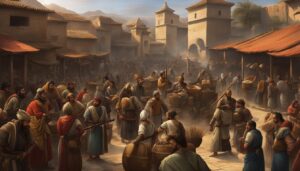
As we delve into the biblical teachings of Jesus, it becomes evident that his parables carry profound meanings. To fully comprehend these timeless lessons, it is essential to understand the cultural context and historical background in which they were shared.
The parables of Jesus often drew upon the societal norms and expectations of his time. They were intricately woven into the fabric of the cultural landscape, making them relatable and impactful to his listeners. By unraveling the hidden meanings behind these parables, we gain deeper insights into the messages Jesus intended to convey.
Key Takeaways:
- The cultural context of Jesus’ parables is crucial to understanding their meaning.
- Jesus employed metaphorical language and religious symbolism in his parables.
- Interpreting parables requires careful analysis of the historical and cultural background.
- The lessons from Jesus’ parables continue to hold relevance in modern life.
- By understanding the cultural significance, we can apply the timeless wisdom to our own lives.
The Socio-Economic Dynamics in Jesus’ Parables: Exploring Symbolism and Interpretation
Jesus’ parables are not only religious teachings, but also powerful narratives that carry deeper symbolic meanings. Through the use of metaphorical language and contextual analysis, these parables provide insights into the socio-economic dynamics of Jesus’ time. Understanding the symbolism and interpretation of these parables allows us to uncover profound truths about human nature, societal structures, and the pursuit of spiritual growth.
One such parable that exemplifies the socio-economic dynamics of Jesus’ teachings is the Parable of the Good Samaritan. In this parable, Jesus challenges the traditional social hierarchies and prejudices of his time by portraying a despised Samaritan as a compassionate and righteous individual. The story highlights the importance of showing kindness and compassion to all, regardless of social status or cultural background. By unpacking the symbolism and analyzing the cultural context, we can apply the timeless lesson of this parable to promote justice, equality, and empathy in our own lives.
Another parable that sheds light on socio-economic dynamics is the Parable of the Workers in the Vineyard. This parable explores issues of fairness and entitlement, as it tells the story of workers who are all paid the same wage regardless of the hours they worked. Jesus uses this parable to challenge societal norms and to emphasize the importance of generosity and grace. By examining the metaphorical language and the cultural context, we gain a deeper understanding of the message conveyed and can apply it to advocate for fairness and generosity in our own communities.
| Parable | Social Theme | Key Lesson |
|---|---|---|
| The Good Samaritan | Social prejudices and compassion | Show kindness and compassion to all |
| The Workers in the Vineyard | Fairness and generosity | Promote fairness and generosity in all dealings |
“Truly I tell you, whatever you did for one of the least of these brothers and sisters of mine, you did for me.” – Matthew 25:40
Jesus’ parables are not just ancient stories; they contain profound wisdom that is applicable to our lives today. By exploring the socio-economic dynamics and interpreting the religious symbolism within these parables, we can gain insights into the human condition and the values that should guide our actions. The lessons from Jesus’ parables encourage us to cultivate empathy, challenge unjust systems, and foster a more inclusive and compassionate society.

The Relevance of Jesus’ Parables Today: Applying the Lessons to Modern Life
As we delve into the biblical narratives of Jesus’ parables, we uncover their enduring cultural significance that extends far beyond the ancient world. These timeless tales continue to resonate with us and offer valuable lessons applicable to our modern lives.
Through the cultural context of the parables, we gain insight into the societal norms and expectations of Jesus’ time. While the settings and characters may differ from our present reality, the underlying moral dilemmas and universal human experiences remain remarkably relatable. By understanding the historical background, we can extract the essence of these parables and apply their teachings to our own lives.
The biblical narratives serve as a bridge between the ancient world and the present, as they touch on fundamental aspects of human nature. Whether it be the Parable of the Good Samaritan teaching us about compassion and empathy or the Parable of the Prodigal Son reminding us of forgiveness and redemption, these stories offer us guidance and wisdom in navigating the complexities of our own time.
By recognizing the cultural context of the parables, we are able to uncover their timeless lessons. Just as they were relevant to the people of Jesus’ time, they continue to hold relevance and speak to the core of our humanity. As we study and reflect upon these parables, we not only gain a deeper understanding of the past but also discover invaluable guidance for our present and future.
FAQ
How can understanding the cultural context of Jesus’ parables enhance our understanding of their meaning?
Understanding the cultural context of Jesus’ parables is crucial because it allows us to grasp the historical background and societal norms of the time, which helps interpret the parables and discern the timeless lessons they convey.
Why is it important to analyze the contextual elements and metaphorical language in Jesus’ parables?
Analyzing the contextual elements and metaphorical language used in Jesus’ parables helps draw out their intended meaning and uncover the deeper truths and religious symbolism they contain.
Can the lessons from Jesus’ parables be applied to modern life?
Yes, the narratives and characters in Jesus’ parables speak to universal human experiences and moral dilemmas, making their lessons relevant in modern life. By understanding the cultural context in which the parables were originally shared, we can apply their timeless lessons to our own lives.








